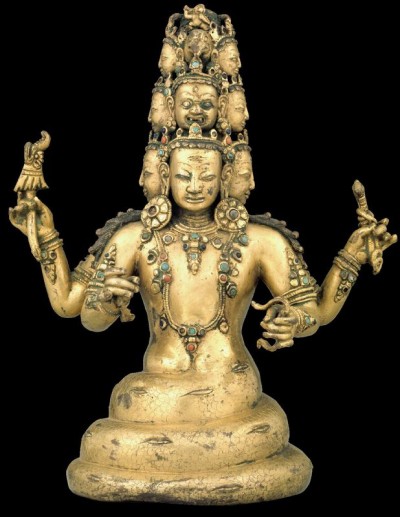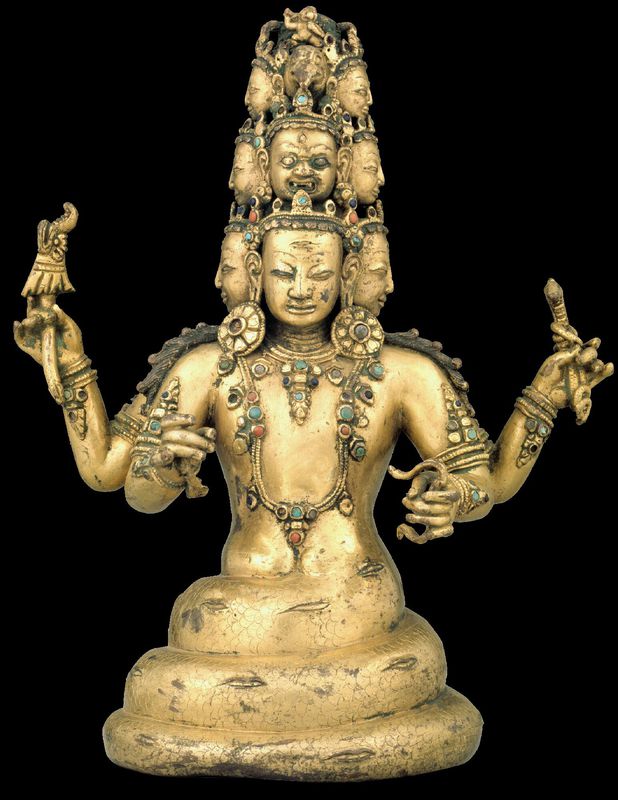
During Brainwave 2016: Emotion, we’re focusing our attention on the emotions that drive our bodies and minds. Fear is known to be one of the most powerful and destructive emotions that people encounter. It seems to cause endless suffering and sometimes becomes a debilitating force in everyday life. But fear no more! Tibetan Buddhist art can help you confront both your mundane and deepest fears.
Browsing through the Rubin Museum galleries, you’ll notice that Tibetan Buddhist art frequently contains imagery and themes that appear ominous and fearful. However, what seems terrifying may actually offer protection from harm or function as a tool to help overcome mental obstructions on the path to enlightenment.
Remember: appearances aren’t always what they seem

There is a positive side to fear—it can make us more aware and motivated. Fear can inspire us to accomplish difficult tasks and help to protect us from potentially harmful situations.
This exquisite statue of Rahula with his nine heads and coiled snake body is an example of a Tibetan Buddhist deity with a terrifying appearance. Rahula’s powers are feared in the Nyingma Buddhist tradition because he is believed to cause strokes in practitioners who do not perform rituals correctly or in a timely manner. Fear of Rahula thus motivates practitioners to take extra care to concentrate on correct ritual practice to avoid potential harm and, as a result, they can attain better spiritual results.
Rahula’s fierce appearance belies his beneficial motives. Fear of Rahula is caused by our attachment to appearances (he looks terrifying!) and our ego. In fact, he is a Buddhist protector who safeguards the revealed treasure teachings known as terma in Tibetan.
Rahula is currently on view in the Masterworks exhibition!
Protect yourself with a charm

Buddhist art includes an abundance of charms, amulets, and other protective devices that people may wear, hang in their homes, or use for certain rituals. The devices are prepared by a Buddhist ritual specialist to activate their protective properties. The Rubin collection includes many intriguing woodblock-printed charms that protect against various threats, such as diseases and wild animal bites. Carrying such a charm while traveling in the remote and mountainous Dolpo region of Nepal—where this charm was acquired—can help assuage your fears!
Seek inner and outer protection

Offering protection from fear is regarded by Buddhists as an act of compassion or a form of giving. Fittingly, Tara—the beloved goddess of compassion—offers protection from the eight great fears or threats, which is a popular subject of Tibetan paintings.
In this beautiful painting, the eight fears are depicted in small vignettes surrounding the large central image of Tara. The fears include wild elephants, bandits, imprisonment, disease (or sometimes flesh-eating demons), snakes, drowning, fire, and lions.
Tara’s protection from these external fears symbolizes overcoming your mental obstacles. While external threats like disease and fire threaten our lives and property, the inner fears inhibit us spiritually and obstruct the path to enlightenment. The inner obstacles that correspond with the external fears are, respectively, ignorance and the untamed mind, false views or preconceived notions, greed and miserliness, doubt, jealousy, attachment, anger, and pride.
Be fearless!
Plan a visit to the Rubin Museum to explore more art and continue to examine your emotions.
On April 1, join us for a conversation on frightening sleep disorders (parasomnias) with novelist Elizabeth Hand and sleep psychologist Carl Bazil.

